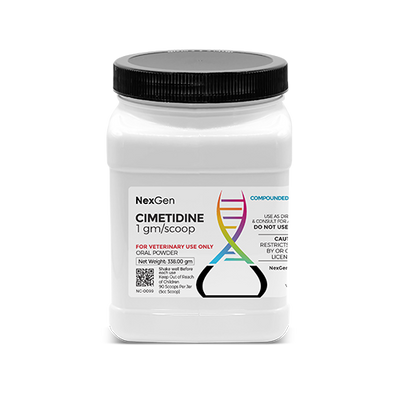
Acetazolamide 1 gm/scoop, Oral Powder, 100 Scoops (5cc Scoop)
Login for pricing
- Brand
- Mixlab
- SKU:
- NC-0010
- Product Type:
- Powder
- Size:
- 32oz
- Administration:
- Oral
- Scoops Per Container:
- 100
- Scoop Size:
- 5cc
Hyperkalemic periodic paralysis (HYPP) is an inherited disease of the muscles in horses that is caused by a genetic mutation. HYPP was one of the first genetic disorders to be reported in the horse. A missense mutation in SCN4A (c.4248C>G) produces an altered alpha chain of the skeletal muscle sodium channel.1 Sodium channels are "pores" in the muscle cell membrane which control contraction of the muscle fibers.2 In horses with the defective sodium channel protein, the channels "leak" and makes the muscle overly excitable and contract involuntarily. Hyperkalemia, which is an excessive amount of potassium in the blood, causes the muscles in the horse to contract more readily than normal.1 This makes the horse susceptible to sporadic episodes of muscle tremors or paralysis.
Symptoms of HYPP
Homozygous horses are affected more severely from HYPP than heterozygous horses.2 Under normal conditions, the defective gene does not appear to have adverse effects, but stress and/or increased potassium in the serum can trigger clinical signs of muscle dysfunction.1 Why some horses manifest severe signs of the disease and other exhibit little or no signs is still under investigation. A horse carrying the defective gene but showing minimal signs however, has the same chance of passing the gene to future generations as an affected horse with severe clinical signs.
HYPP is characterized by sporadic attacks of muscle tremors, weakness and/or collapse.1 Attacks can also be accompanied by loud breathing as a result of paralysis of the muscles of the upper airway. Occasionally, sudden death can occur following a severe paralytic attack, presumably from heart failure or respiratory muscle paralysis.2
Episodes of HYPP can take various forms; these have commonly been confused with other conditions. Because of the muscle tremors and weakness, HYPP often resembles exertional rhabdomyolysis ("tying-up" syndrome). A distinguishing feature of HYPP from "tying-up" syndrome is that horses usually appear normal following an attack of HYPP, whereas horses with "tying-up" syndrome have a stiff gait and painful, firm muscles after an episode.2
During a severe attack of HYPP, emergency treatment from a veterinarian is necessary. For long term therapy, many horses can be managed by exercise and diet control alone.
Causes of HYPP Attacks
It has been reported that environmental factors can actually cause an HYPP attack.2 Owners of HYPP-positive horses should be aware that external stimulus and events could increase the chance of paralysis onset. These factors include dietary changes, fasting, general anesthesia, and concurrent illness and exercise restriction.
Dietary management is extremely important in the management of affected horses.2 Dietary adjustments that should be made in HYPP-positive horses include:
-
Feeding several times a day
-
Avoiding high potassium feeds such as alfalfa hay, brome hay, canola oil, soybean meal or oil, and sugar molasses and beet molasses in favor of timothy or Bermuda grass hay, grains such as oats, corn, wheat and barley and beet pulp
-
Exercising regularly and/or being allowed frequent access to a large paddock or yard
There is a popular misconception that if a horse does not show any signs up to a certain age, it does not carry the trait. Unfortunately, this is not the case. Horses with HYPP are affected for life.1
Treatment of HYPP
Chiefly, two drugs have been used for prevention of clinical episodes of paralysis. Horses have been treated with either acetazolamide (acetazolamide sodium) or hydrochlorthiazide with success.2 Acetazolamide has been shown to stabilize blood glucose and potassium by stimulating insulin secretion. Breed registries do have restrictions on the use of these drugs during competitions, with some requiring a veterinary certificate.
Acetazolamide for Horses
Acetazolamide has some anticonvulsant activity, which is independent of its diuretic effects. This mechanism is not fully understood but may be caused by an effect on carbonic anhydrase in the brain or induction of metabolic acidosis. In a study comparing the effects of acetazolamide and methazolamide in anesthetized cats, methazolamide did not reduce the hypoxic ventilatory response, but acetazolamide did.3 The study authors believe this response was not a result of carbonic anhydrase inhibition but instead was caused by acetazolamide’s effects on carotid bodies or type I cells.4
Where to buy Acetazolamide
Acetazolamide is available in the U.S. through several pharmaceutical manufacturers and through veterinary custom compounding companies.
Please consult a licensed veterinarian prior to beginning any treatment regimen.
FOR RX ONLY: A valid prescription from a licensed veterinarian is required for dispensing this medication.
1Steiss, J. E., & Naylor, J. M. (1986). Episodic Muscle Tremors in a Quarter Horse: Resemblance to Hyperkalemic Periodic Paralysis. Canadian Veterinary Journal, 27(9), 332-335.
2Spier, S. J., Carlson, G. P., Holliday, T. A., Cardinet III, G. H., & Pickar, J. G. (1990). Hyperkalemic periodic paralysis in horses. Journal of the American Veterinary Medical Association, 197(8), 1009-1017.
4Teppema LJ, Bijl H, Gourabi BM, Dahan A. The carbonic anhydrase inhibitors methazolamide and acetazolamide have different effects on the hypoxic ventilatory response in the anaesthetized cat. J Physiol. 2006;574(2):565-572.


















